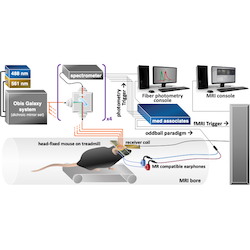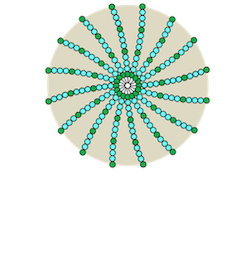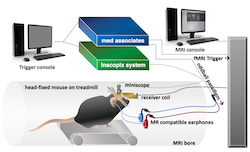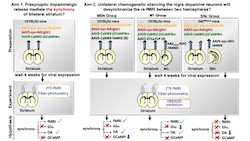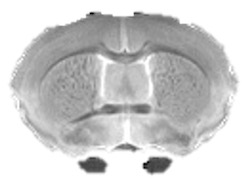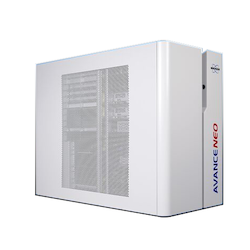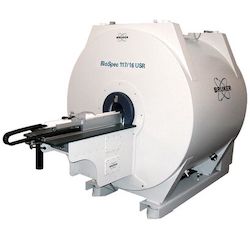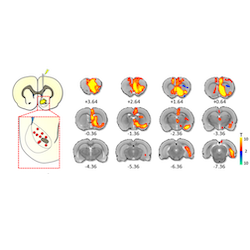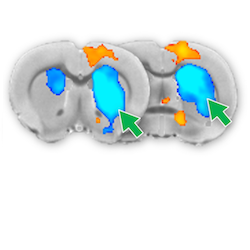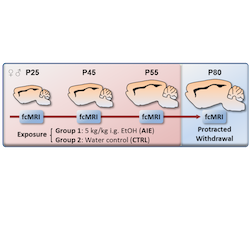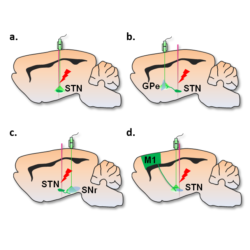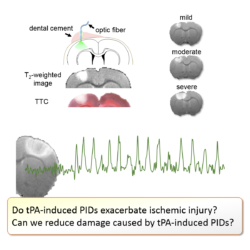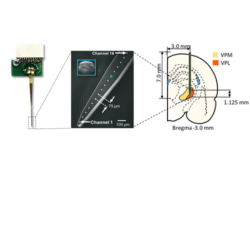Circuit Mechanisms Governing the Default Mode Network
(R01 MH126518, PI: Shih)
Non-invasive functional magnetic resonance imaging (fMRI) has revolutionized our understanding of macroscopic functional brain networks. However, inherent constraints of current fMRI methodologies in humans limit our ability to probe the mechanisms underlying these networks. The overarching goal of this project is to shed light on cellular and circuit mechanisms underlying the functional organization of the Read more about Circuit Mechanisms Governing the Default Mode Network<br>(R01 MH126518, PI: Shih)[…]
SORDINO-fMRI for mouse brain applications (R01 EB033790, PI: Shih)
PROJECT SUMMARY Gradient-recalled echo (GRE)–based echo planar imaging (EPI) has been the gold standard functional magnetic resonance imaging (fMRI) technique for nearly three decades due to its ability to rapidly acquire whole brain volumes with MR T2* sensitivity to blood oxygenation — a well-known surrogate marker for brain activity. This immensely utilized technique, however, suffers Read more about SORDINO-fMRI for mouse brain applications (R01 EB033790, PI: Shih)[…]
Concurrent high resolution calcium imaging and fMRI reveal intra anterior cingulate cortex neuronal activity and large-scale brain network connectivity in healthy and nicotine-addicted mice
(R21 DA057503, PI: Hsu and Shih)
Using functional magnetic resonance imaging (fMRI), studies have provided significant insights into unique large-scale functional organizations of the brain including default mode network (DMN) and salience network (SN). The aberrant communications of brain functional connectivity among these networks have been observed across different classes of addiction and are associated with craving and relapse. The overarching Read more about Concurrent high resolution calcium imaging and fMRI reveal intra anterior cingulate cortex neuronal activity and large-scale brain network connectivity in healthy and nicotine-addicted mice <br>(R21 DA057503, PI: Hsu and Shih)[…]
Deciphering neural origins of interhemispheric striatal resting-state functional connectivity using simultaneous chemogenetic fMRI and triple-spectral fiber photometry
(R21 NS133913, PI: Zhang and Shih)
We propose to elucidate the neural origins of interhemispheric striatal resting-state fMRI (rs-fMRI) connectivity using simultaneous fMRI and spectrally resolved triple-color fiber photometry. It is of paramount interest to understand the mechanism by which noninvasive rs-fMRI signals is formed. Successful completion of this work will provide evidence-based interpretation of the rs-fMRI connectivity results between striatum Read more about Deciphering neural origins of interhemispheric striatal resting-state functional connectivity using simultaneous chemogenetic fMRI and triple-spectral fiber photometry<br>(R21 NS133913, PI: Zhang and Shih)[…]
Metal-free, genetically encoded reporters for calcium recording with MRI (R01 NS128278, PI: Mukherjee, Kippin, and Shih)
Many leading questions in neuroscience such as how neurons encode experience, modify behavior, and degenerate, require neural activity to be monitored throughout the brain in living animals. Neuronal activity is tightly linked to an increase in intracellular calcium. Therefore, a cornerstone technology for monitoring neural activity involves the use of genetically encoded fluorescent reporters of Read more about Metal-free, genetically encoded reporters for calcium recording with MRI (R01 NS128278, PI: Mukherjee, Kippin, and Shih)[…]
Avance neo upgrade for the biospec 9.4T/30CM MRI system at UNC
(NIH S10 MH124745, PI: Shih)
Animal magnetic resonance imaging (MRI) research at the University of North Carolina (UNC) at Chapel Hill has been supported by a single Bruker Biospec 9.4T/30cm animal MRI system installed in 2006. This scanner has been widely utilized by 96 investigators in the Research Triangle area of North Carolina, with the majority of the research projects Read more about Avance neo upgrade for the biospec 9.4T/30CM MRI system at UNC<br>(NIH S10 MH124745, PI: Shih)[…]
9.4T Small Animal MRI scanner at UNC
(S10 OD026796, PI: Shih)
Animal magnetic resonance imaging (MRI) research at the University of North Carolina (UNC) at Chapel Hill has been supported by a single Bruker Biospec 9.4T animal MRI scanner installed in 2006. This scanner has been widely utilized by 96 investigators in the Research Triangle area of the North Carolina. This application requests funds to purchase Read more about 9.4T Small Animal MRI scanner at UNC<br>(S10 OD026796, PI: Shih)[…]
Deep brain stimulation probe insertion system utilizing ultrasonic vibration for less invasive implantation with improved targeting accuracy for addiction therapy
(NIH R43 DA051265, subcontract PI: Lee)
This Phase I SBIR develops and tests a Deep Brain Stimulation Probe Insertion System Utilizing Ultrasonic Vibration for Less Invasive Implantation with Improved Targeting Accuracy for Addiction Therapy. This submission is in response to: RFA –19-019 HEAL Initiative: America’s Startups and Small Businesses Build Technologies to Stop the Opioid Crisis. Problem to be solved: Currently, Read more about Deep brain stimulation probe insertion system utilizing ultrasonic vibration for less invasive implantation with improved targeting accuracy for addiction therapy<br>(NIH R43 DA051265, subcontract PI: Lee)[…]
Mechanisms underlying positive and negative BOLD in the striatum
(NIH BRAIN Initiative RF1 MH117053, PI: Shih)
Our understanding of human brain function has been heavily influenced by functional magnetic resonance imaging (fMRI) – a technique that measures neuronal activity indirectly through blood oxygenation changes. Accumulating data indicates that our interpretation of fMRI data could have been wrong, or even opposed to the actual neuronal processes in a brain area called striatum. Read more about Mechanisms underlying positive and negative BOLD in the striatum<br>(NIH BRAIN Initiative RF1 MH117053, PI: Shih)[…]
Effects of adolescent alcohol exposure on functional brain connectivity
(NIH K01 AA025383, PI: Broadwater)
Numerous studies suggest that alcohol exposure during adolescence results in persistent detrimental effects on brain, with the prefrontal brain regions being particularly vulnerable. Using resting-state fMRI, the projects outlined in this mentored K01 award will characterize the development of frontal brain connectivity in rats and investigate how brain connectivity may be altered after adolescent alcohol Read more about Effects of adolescent alcohol exposure on functional brain connectivity <br>(NIH K01 AA025383, PI: Broadwater)[…]

